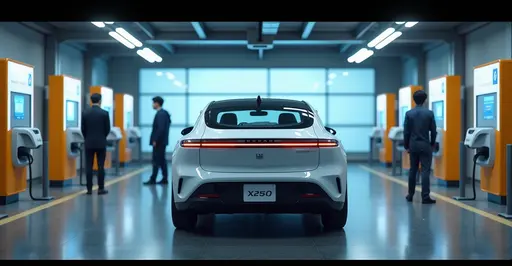
Tokyo Launches Major EV Battery Swapping Network
In a groundbreaking move for electric vehicle infrastructure, a consortium including Mitsubishi Fuso, Mitsubishi Motors, Ample, and Yamato Transport has launched a large-scale battery swapping initiative across Tokyo. Starting September 2025, the project will deploy over 150 battery-swappable commercial EVs and 14 modular swapping stations throughout Japan's capital.
5-Minute Power Boost
The system enables drivers to exchange depleted batteries for fully charged units in just five minutes without leaving their vehicles. This addresses the primary pain point for commercial fleets: downtime during charging. "For delivery services like ours, every minute counts," stated Seiichi Awa, President of Yamato Transport, Japan's largest logistics group and the initiative's first major customer.
Strategic Climate Solution
Supported by the Tokyo Metropolitan Government's "Technology Development Support Project for Promoting New Energy," the initiative directly supports Japan's goal to cut greenhouse gas emissions by 46% from 2013 levels by 2030. Transportation accounts for 19% of Japan's CO₂ emissions, making fleet electrification crucial.
Global Swapping Expansion Gains Momentum
This Tokyo rollout follows NIO's ambitious "Power 2025" plan announced in 2021. The Chinese automaker has since deployed over 2,250 swap stations globally and aims for 4,000 by 2025-end, with 1,000 outside China. "By 2025, 90% of NIO users will live within 3km of a swap station," a company representative confirmed.
How Battery Swapping Works
The automated process involves:
- Vehicle alignment on platform
- Robotic removal of depleted battery
- Insertion of fully charged unit
- System diagnostics verification
Overcoming Historical Challenges
Battery swapping isn't new. Early experiments date back to 1896, with significant implementations for electric trucks in the 1910s. Modern attempts faced hurdles:
Learning from Failures
- Better Place (2013): Filed bankruptcy after installing swap stations in Israel and Denmark
- Tesla (2015): Abandoned swap technology despite demonstrating 90-second exchanges
- Zotye Auto (2011): Halted taxi program after battery fire
"Standardization was the missing piece," explains EV analyst Kenji Tanaka. "Today's modular systems like Ample's work across vehicle types, making the model scalable."
The Road Ahead
The Tokyo project remains open to additional automakers and operators. Battery-as-a-Service (BaaS) models are gaining traction, separating battery costs from vehicle prices. As Khaled Hassounah, CEO of Ample, notes: "Swapping makes EVs accessible for drivers without home charging and extends battery lifespan through professional management."
With Japan targeting carbon neutrality by 2050 and global EV sales accelerating, battery swapping stations could become as common as gas stations within this decade.

 Nederlands
Nederlands
 English
English
 French
French
 Deutsch
Deutsch
 Espaniol
Espaniol
 Portugese
Portugese



